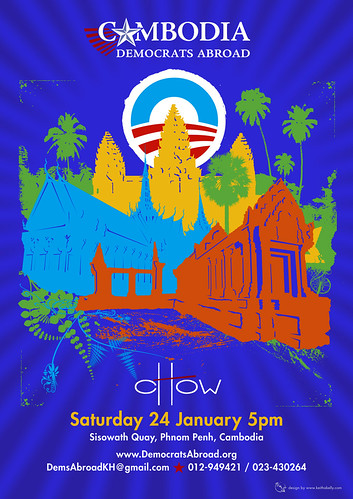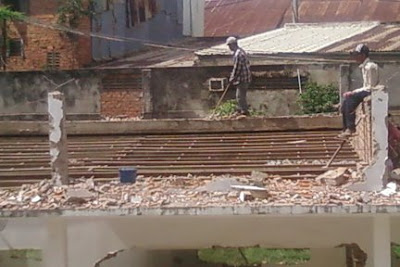I have to say that Keith is the most amazing graphic artist ever. He just reaches into his creative depths and pumps them out. How cool is this?? We plan on making the Huffington Post again, as well as the other major news carriers, so keep an eye out for live feed from Cambodia! (and I’m angry with Ben for planning his dinner party on the same night and without me!!)
Cambodia
… far from roads in rural Kampot
 This 18 year old mother was taking her baby to the health centre. This facility, built just last year with funds from a German NGO (can you tell it’s new?), is relatively far from the primary and secondary roads and can’t be accessed by vehicle.
This 18 year old mother was taking her baby to the health centre. This facility, built just last year with funds from a German NGO (can you tell it’s new?), is relatively far from the primary and secondary roads and can’t be accessed by vehicle. 



This is the main transport option in rural areas. You can’t see the motorbike pulling this remorque (it’s basically a wagon that can hold up to 35 Khmer). It’s a horrible bumpy ride (I feel this way and I’m healthy, imagine a pregnant mother about to deliver riding this contraption up to 15km to get to a skilled birth attendant!).
Development efforts –ours and a host of others working in MCH (Maternal and Child Health)– sadly haven’t sufficiently implemented a continuum of care to respond to this access barrier.
Cambodia had the highest Maternal Mortality Rate (31st highest in the world) in 2000 at 450 deaths/100,000 live births. There was no progress by the Cambodian Demographic Health Survey 2005, when it peaked at 473/100,000. 
Here’s another form of transport, but only if there’s no rush!



View outside my office window: demolition
beyond Phnom Penh.. in Kampong Cham
 Photos courtesy of K Kelly
Photos courtesy of K Kelly
We just wanted to go for a walk to get some air, after two whole days indoors through several ceremonies. We attended a Buddhist ceremony in Kampong Cham for a friend’s grandmother who passed away 10 years ago. This is the province with the beautiful women, according to many Khmer men in Phnom Penh. It might somewhat be validated by the recent legislative crackdown on weddings to foreigners, to prevent trafficking of women. Apparently Korean men looking for a nice obedient wife tend to look for one to buy/marry in this province, until several miraculously escaped abusive relationships in S Korea and reported it upon return.
But I digress. This couple were guests at the event, and we inadvertently followed them home. When we indicated through various gesturing and mimings that we wanted to walk around the village a bit, they wouldn’t have that– “dangerous”, they said. “Come with us to our house.”

There they served us up some tea and cashew fruits. The lands to and around Kampong Cham are dedicated to farming cashews and rubber plantations. The soil is particularly good for growing very high quality cashews, but they are mostly grown for export to Vietnam and Thailand. The Khmer in turn imports Vietnam’s sub-par cashews to sell to its own people. Rubber is exported to China. It fetches high prices, but not high enough to compensate for the damage it renders the soil after a few years of high yield. The agriculture policy is still not effectively implemented, and besides, there’s very little regulatory capacity not to mention intense corruption when it comes to land and land use. Small farmers are pretty much left to their own devices and vulnerable to the demands of neighbors and subsequent market imbalances. 
They eat the flesh of the cashew fruit here, not just the nut. The older folks especially love it (maybe cuz it’s soft?) dipped into a sauce of palm sugar and water.
A common sight


Photos courtesy of H. Prytherch
This is a common sight along the roads of Cambodia– a patient riding on the back of a moto on the way home, hooked up to an IV. There’s large demand for IVs and injections in the country, and people seek it out whether or not it is medically necessary. The problem of overuse of drugs/IVs is more prevalent in rural areas where educational levels are much lower.
We asked some people in the communities when they typically get IVs, and we were told it’s good for making the body strong again after many days out fishing or working in the fields. We’re told they can be bought at any pharmacy or clinic, and the colored IVs are better because the medicine in it makes it more potent. (Unknown to them, oftentimes it is due to food coloring by unscrupulous drug vendors capitalising on the poor knowledge of drug use.)
…I can almost see the image of this in the bas reliefs of Angkor Wat!
How to vote in Cambodia’s national elections
Tomorrow the country holds its 4th national elections since the 1991 Paris Peace Accords were signed, ending decades of civil war and foreign occupation. In the runup to this weekend our counterparts in the Ministry of Health and all health professionals were required to partake in campaigning for their parties. (This meant that all activities agreed upon were essentially put on hold for two months).
I asked one of them, a hospital director, what it is he does when he goes out to the villages and communities to campaign. “I teach people how to vote”, was the response. Really? How do you teach them how to vote? “I show them which box on the ballot to check”. Do you like to do that? [[He hesitates, then…]] “It doesn’t seem right… But it’s good for CPP to win so that we won’t have violence again. And I’m a doctor and I have responsibilities so I should vote for CPP.”
The dominant CPP party had to settle for a coalition government with FUNCINPEC because they didn’t win the required 2/3 majority in the 2003 elections, and the PM has taken steps to ensure that won’t happen again. CPP’s campaign was largely about threatening violence if CPP does not take a majority.
Needless to say, people in a generally subdued mode…






